Frances Mayes's Blog, page 7
February 27, 2012
What We Served and Didn't Serve to Alberto
When our great friend Alberto breaks off from an intense work schedule and flies up to NC from Tampa for only one night, he must enjoy a sustaining dinner, one that reminds him of Tuscany! Alberto owns the house above Bramasole. We share Italy on many levels, and back in the USA, our interests also intersect and blossom. If you read Every Day in Tuscany, you've already heard of our friendship. He, Ed, and I, when we get together, talk non-stop of creative plans–from creating a whole town to painting a five-inch watercolor to solving the humidity problem on the back wall of his house. A day can be long and short when there's so much to say.
First we sat by the fire and opened a prosecco–Rustico, what we often drink in Cortona. With some crackers and olives, we devoured–and practically shouted over–a three-milk, grassy, chalky cheese from Piemonte: La Tur. Such a creamy, pillowy delight!
At the table, we began with When in Rome Artichokes. We talked about a poetry / art project for Ed and Alberto based on architectural fragments around Italy–the Etruscan stairs at Tarquinia, the Jovis ruins at Capri, the disappeared villa of Pliny near Città di Castello. The talk paired easily with the ancient thistle stuffed with black olives, croutons, basil, parsley, drizzled with olive oil and lemon juice. I'm only half-kidding–shouldn't the music and talk complement the food as much as the wine?

We decided to skip the crab and lemon pasta we'd planned. Too much cheese, which quickly satiates you. I normally serve cheese only at the end of dinner. I was just in love with La Tur–that melting goodness–and wanted to share it immediately.
So, we moved on to Tuscan Short Ribs with Rich Polenta–from The Tuscan Sun Cookbook–and grilled asparagus. This is such a hearty, wintery recipe that to feast on it, you feel you should have been out in the woods chopping logs or hiking snow-covered Roman roads. The ribs are browned, then slow-roasted with soffrito, sautéed carrots, garlic, onions, and celery, and long-roasted with chopped tomatoes. Low and slow–that's the secret. Like osso bucco, the ribs' meat just slips off –it's that tender–leaving the primitive bones clanking on your plate. Talk was heady: the Danteum of Terragni, a Fascist-era architect's memorial to Dante, the only building we know of that was based on a book. It was never built but the plans linger with power. (Terragni's Danteum by Thomas L. Schumacher). Perhaps a bit too ethereal a conversation for such an earthy dish. With such a savory sauce, and this is one of the best things you can put in your chops, we pass the bruschette smeared with roasted garlic.

Oh, my. This tastes so deeply of Tuscany. (That's Ed, pressing out the pulp from the roasted garlic.)
So, we skipped the salad, too. The chopped, crisp romaine with roasted beets and walnuts and crumbled gorgonzola. Maybe, by then, it was the Brunello talking. We were onto plans for designing tableware for a restaurant, and the ideal seasonal menu, and the name of this restaurant.
By this time, the camera was forgotten. Please imagine the intense, roasty ribs on a bed of golden polenta! We moved on to Wallace Stevens, Cortona news, Caravaggio, and a sweet pannacotta with raspberries and blueberries. Why is this dessert so popular in Tuscany? Because it is the easiest dessert imaginable. You make it in ten minutes and can embellish it with a purée of strawberries, a slather of chocolate sauce, or simply seasonal berries. We lingered long at the table, though we did not, as we would have in Tuscany, haul out the grappa. Just espresso. After midnight, we said buona notte, already a bit sad that the trip to the airport would start shortly after breakfast, and that we would be texting and calling and e-mailing until we can meet again this spring on our beloved hillside overlooking the valley where Hannibal defeated the Romans in 217 B.C.
February 26, 2012
What We Served and Didn’t Serve to Alberto
When our great friend Alberto breaks off from an intense work schedule and flies up to NC from Tampa for only one night, he must enjoy a sustaining dinner, one that reminds him of Tuscany! Alberto owns the house above Bramasole. We share Italy on many levels, and back in the USA, our interests also intersect and blossom. If you read Every Day in Tuscany, you’ve already heard of our friendship. He, Ed, and I, when we get together, talk non-stop of creative plans–from creating a whole town to painting a five-inch watercolor to solving the humidity problem on the back wall of his house. A day can be long and short when there’s so much to say.
First we sat by the fire and opened a prosecco–Rustico, what we often drink in Cortona. With some crackers and olives, we devoured–and practically shouted over–a three-milk, grassy, chalky cheese from Piemonte: La Tur. Such a creamy, pillowy delight!
At the table, we began with When in Rome Artichokes. We talked about a poetry / art project for Ed and Alberto based on architectural fragments around Italy–the Etruscan stairs at Tarquinia, the Jovis ruins at Capri, the disappeared villa of Pliny near Città di Castello. The talk paired easily with the ancient thistle stuffed with black olives, croutons, basil, parsley, drizzled with olive oil and lemon juice. I’m only half-kidding–shouldn’t the music and talk complement the food as much as the wine?

We decided to skip the crab and lemon pasta we’d planned. Too much cheese before dinner, which quickly satiates you. I normally serve cheese only at the end of dinner. I was just in love with La Tur–that melting goodness–and wanted to share it immediately.
So, we moved on to Tuscan Short Ribs with Rich Polenta–from The Tuscan Sun Cookbook–and grilled asparagus. This is such a hearty, wintery recipe that to feast on it, you feel you should have been out in the woods chopping logs or hiking snow-covered Roman roads. The ribs are browned, then slow-roasted with soffrito, sautéed carrots, garlic, onions, and celery, and some chopped tomatoes. Low and slow–that’s the secret. Like ossobuco, the ribs’ meat just slips off –it’s that tender–leaving the primitive bones clanking on your plate. Talk was heady: the Danteum of Terragni, a Fascist-era architect’s memorial to Dante, the only building we know of that was based on a book–other than Tara, as one of the comments below insisted! The Danteum was never built but the plans linger with power. (Terragni’s Danteum by Thomas L. Schumacher). Perhaps a bit too ethereal a conversation for such an earthy dish. With such a savory sauce, and this is one of the best things you can put in your chops, we pass the bruschette smeared with roasted garlic.

Oh, my. This tastes so deeply of Tuscany. (That’s Ed, pressing out the pulp from the roasted garlic.)
So, we skipped the salad, too. The chopped, crisp romaine with roasted beets and walnuts and crumbled gorgonzola. Maybe, by then, it was the Brunello talking. We were onto plans for designing tableware for a restaurant, and the ideal seasonal menu, and the name of this restaurant.
By this time, the camera was forgotten. Please imagine the intense, roasty ribs on a bed of golden polenta! We moved on to Wallace Stevens, Cortona news, Caravaggio, and a sweet panna cotta with raspberries and blueberries. Why is this dessert so popular in Tuscany? Because it is the easiest dessert imaginable. You make it in ten minutes and can embellish it with a purée of strawberries, a slather of chocolate sauce, a spoon of lemon marmalade, or simply seasonal berries. We lingered long at the table, though we did not, as we would have in Tuscany, haul out the grappa. Just espresso. After midnight, we said buona notte, already a bit sad that the trip to the airport would start shortly after breakfast, and that we would be texting and calling and e-mailing until we can meet again this spring on our beloved hillside overlooking the valley where Hannibal defeated the Romans in 217 B.C.
February 17, 2012
Frankye's Marshmallow Fudge Cake
Willie is turning 10—double digits. When I asked what cake he wanted to take to his class, he answered as he did last year: that chocolate cake with the marshmallows. My daughter wanted the same when she was small, as did I. My mother preferred to make a pound cake with hard white icing that she could decorate with little pink and pale green rosettes. I put up with that when I was four but when she made it the next year, too, I got under the bed and would not come out for my party. Such is the power of the Marshmallow Fudge Cake.
Marshmallows are not a staple of my pantry, but this weekend we are encountering them twice. After the movie and dinner for Willie's friends, we're building a bonfire in the meadow for the making of S'mores.
The cake is dense, similar to brownies, even though egg whites are beaten stiff, then folded into the batter. Ed likes to demonstrate when the whites are ready by holding the copper bowl upside down over his head. Recently he did that twice. The sides had slicked enough by the second time that the whites slid out all over him and the floor. Much appreciated by his audience of three!

Marshmallows are studded over the cake.

Then the icing is poured over. It doesn't have to cover the sides because that's just too much of a good thing.

Last year, several third- grade classmates asked my daughter for the recipe! Now that is success in the kitchen!
Here's the recipe. I doubled it this time. Be sure to sift the powdered sugar into a snowy mountain.

Cake:
Preheat oven to 350 degrees
1 cup boiling water
½ cup unsweetened cocoa
2 cups flour, sifted
1 teaspoon each baking powder and baking soda
½ cup butter, softened
1 ½ cups sugar
2 eggs, separated
1 teaspoon vanilla
¾ cup milk
Make a paste of the hot water and cocoa. Slightly cool. Sift together the flour, baking powder and baking soda. In a separate bowl, cream together the butter and sugar then beat in the two yolks. Beat the whites in a copper or metal bowl until stiff. Combine the cocoa mixture and the eggs / sugar and blend well. Add the vanilla. Beat the flour and milk alternately into the batter, then, when well incorporated, fold in the whites.
Pour into a buttered, parchment-lined 9 x 13 (or slightly larger) pan and bake for 15 minutes if you have a convection oven, or 20 minutes in a normal oven. Don't overbake it! The instant it's firm, take it out. My mother lined her pans with waxed paper.
The original recipe calls for sour milk. I don't ever have that on hand, though I could add a little lemon juice to regular milk—that passes for sour milk. I just use whole milk.
Let the cake cool before turning it out. When totally cool, stud the top with marshmallows. I use the fancy kind from Whole Foods but never met anything but the regular ones until recently.
Make the icing and pour it over the marshmallows. Let it cool and harden before covering with plastic wrap.
Icing:
½ cup unsweetened cocoa
½ stick butter, melted
Pinch of salt
½ cup whole milk
1 teaspoon vanilla
2 cups powdered sugar, sifted
Stir the cocoa into the warm butter until all the little lumps are gone. Add the salt, milk, and vanilla. Add a scoop of powered sugar and blend before adding more scoops. The icing should not be too thick to pour. Add a bit more milk if you need to for the proper consistency.

There it is–Frankye's immortality, though she'd prefer, I imagine, that I praise her Lane Cake, Caramel Cake, or Coconut Cake instead. But this is chocolate southern decadence!
If there's an almost ten-year old around to lick the spoon–even better!
Frankye’s Marshmallow Fudge Cake
Willie is turning 10—double digits. When I asked what cake he wanted to take to his class, he answered as he did last year: that chocolate cake with the marshmallows. My daughter wanted the same when she was small, as did I. My mother preferred to make a pound cake with hard white icing that she could decorate with little pink and pale green rosettes. I put up with that when I was four but when she made it the next year, too, I got under the bed and would not come out for my party. Such is the power of the Marshmallow Fudge Cake.
Marshmallows are not a staple of my pantry, but this weekend we are encountering them twice. After the movie and dinner for Willie’s friends, we’re building a bonfire in the meadow for the making of S’mores.
The cake is dense, similar to brownies, even though egg whites are beaten stiff, then folded into the batter. Ed likes to demonstrate when the whites are ready by holding the copper bowl upside down over his head. Recently he did that twice. The sides had slicked enough by the second time that the whites slid out all over him and the floor. Much appreciated by his audience of three!

Marshmallows are studded over the cake.

Then the icing is poured over. It doesn’t have to cover the sides because that’s just too much of a good thing.

Last year, several third- grade classmates asked my daughter for the recipe! Now that is success in the kitchen!
Here’s the recipe. I doubled it this time. Be sure to sift the powdered sugar into a snowy mountain.

Cake:
Preheat oven to 350 degrees
1 cup boiling water
½ cup unsweetened cocoa
2 cups flour, sifted
1 teaspoon each baking powder and baking soda
½ cup butter, softened
1 ½ cups sugar
2 eggs, separated
1 teaspoon vanilla
¾ cup milk
Make a paste of the hot water and cocoa. Slightly cool. Sift together the flour, baking powder and baking soda. In a separate bowl, cream together the butter and sugar then beat in the two yolks. Beat the whites in a copper or metal bowl until stiff. Combine the cocoa mixture and the eggs / sugar and blend well. Add the vanilla. Beat the flour and milk alternately into the batter, then, when well incorporated, fold in the whites.
Pour into a buttered, parchment-lined 9 x 13 (or slightly larger) pan and bake for 15 minutes if you have a convection oven, or 20 minutes in a normal oven. Don’t overbake it! The instant it’s firm, take it out. My mother lined her pans with waxed paper.
The original recipe calls for sour milk. I don’t ever have that on hand, though I could add a little lemon juice to regular milk—that passes for sour milk. I just use whole milk.
Let the cake cool before turning it out. When totally cool, stud the top with marshmallows. I use the fancy kind from Whole Foods but never met anything but the regular ones until recently.
Make the icing and pour it over the marshmallows. Let it cool and harden before covering with plastic wrap.
Icing:
½ cup unsweetened cocoa
½ stick butter, melted
Pinch of salt
½ cup whole milk
1 teaspoon vanilla
2 cups powdered sugar, sifted
Stir the cocoa into the warm butter until all the little lumps are gone. Add the salt, milk, and vanilla. Add a scoop of powered sugar and blend before adding more scoops. The icing should not be too thick to pour. Add a bit more milk if you need to for the proper consistency.

There it is–Frankye’s immortality, though she’d prefer, I imagine, that I praise her Lane Cake, Caramel Cake, or Coconut Cake instead. But this is chocolate southern decadence!
If there’s an almost ten-year old around to lick the spoon–even better!
February 14, 2012
Agretti and Other Greeny Greens
About this time in Tuscany, we begin to see agretti at the markets. It's a grassy green, just so fresh–and slightly bitter. We steam it briefly and then run it around in a sauté pan with garlic and olive oil, great olive oil of course. Next time I'm there, I'm going to buy seeds to bring back because I've never seen it here in the U.S. With every bite you get a full quote of Popeye vitamins!

Today is Valentine's so I should be thinking RED, but all I can see this morning is green. Maybe it's because I'm still tasting my friend Ann's hearty spinach and lentil soup from last night, and her vegetable salad.
Here is one of Steven Rothfeld's photos from our forthcoming cookbook. Cutest vegetable in the world? The round zucchini can be hollowed and stuffed with whatever you want. Here, they're filled with breadcrumbs, tomato, herbs, onions.
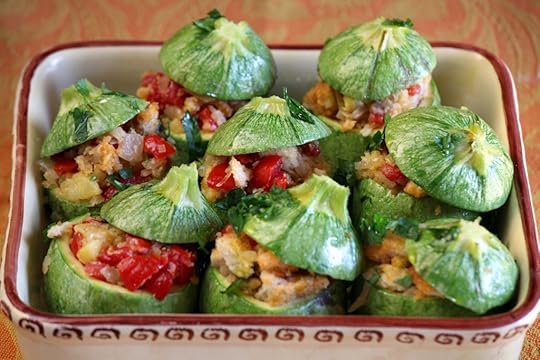
The vegetable section of the book may be my favorite. This is cavolo nero, black cabbage, from our garden. It is such a fierce vegetable! We tame it in kale, sausage, and cannellini bean soup. That color–how to describe it–a slate green, toad frog green, stone green?

Recently I've seen recipes for raw kale in salads. Has anyone tried that? It seems unlikely to me. With the chard and kale we grow, we usually harvest a bunch and steam it, then form softball-sized rounds and freeze them. So handy for a quick sauté or for risotto.
On a cold January day, I took this outside a small shop in Florence. Not shown is my winter favorite broccoli romano, pyramidal and intricate. It tastes like winter. These rosy cauliflowers are delicious when roasted. (Whoever invented cauliflower with cheese sauce–ugh!) Divide them into flowerets, place on a parchment-lined baking sheet, tent with foil, and roast at 350 for about ten minutes. Remove the foil and continue roasting until they are really done and browning. I treat root vegetables the same way. I roast carrots, parsnips, and onions, adding quartered apples for the last 10-15 minutes. A perfect supper with a roast chicken.
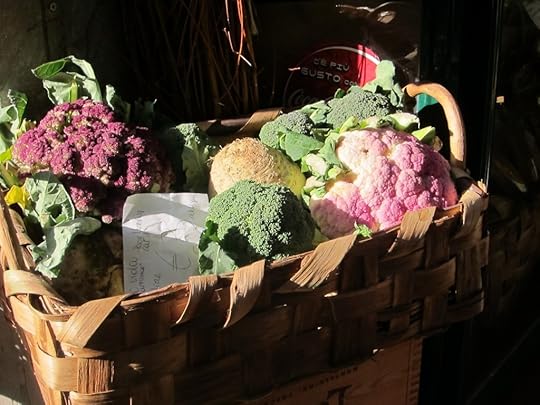
Many of my best vegetables are simple. But like just the right scarf with a sweater, the subtle additions make all the difference–as in gently steamed green beans tossed with black olives and orange zest. Since I'm dreaming in green today, here's a summer shot of our orto, vegetable garden in Italy. There's a grand plenty–enough to share with friends–and going there to pick dinner is a big pleasure.
[image error]
February 11, 2012
Antipodean Tuscan Sun
We raising a glass of something very good tonight to Fiona Henderson and the HarperCollins team in Australia. They just sent their edition of our cookbook and we love the design!


The seafood on the back cover is served over puréed cannellini beans. This was photographed at our mountain house. It makes me want to pack and run to the airport. But, of course, it's snowing right now in Tuscany, more than since 1985!
Grazie mille, friends, for publishing this gorgeous edition!!
February 6, 2012
Winter Reading
The stack of books waiting by my bed has risen to tottering height. So much to read and already the spring garden is calling. I want to recommend Ecology of a Cracker Childhood and Drifting into Darien, both by Georgia writer Janisse Ray. She is a memoir writer and and ecologist / naturalist who grew up in Baxley, Georgia (near where I grew up in Fitzgerald). Her home was in a junkyard, her family self-proclaimed "crackers," and the upbringing strange enough for any southern writer. The apostolic church, the state insane asylum, the cooky grandfather, etc., etc. are background music to Ray's developing love of the land she sprang from. She writes prose odes to the Altamaha River as she makes her way down it by boat. I newly appreciate the astounding flora and fauna of the region. And I always like to see writers from unlikely backgrounds soar.
I read several novels in January that I would pass on to you if you were my neighbor: Swamplandia by Karen Russell, The Fireman's Fair by Josephine Humphreys, and If You Lived Here by Diana Sachs–all three good pull-up-by -the-fire books. I also read three others that I would not recommend–so no use to mention them and hurt the authors' feelings. I'm deeply into Barry Hannah's Long Last Happy: New and Selected Stories. He's, of course, a one-off writer, deeply quirky and sprung with life. Next, I'm launching into The Man Without Qualities by Robert Musil. My friend Rena says it's the best book she's ever read; she fell into the Musil-world as if down the rabbit hole. She recommends the Wilkins / Pike translation. 1130 pages! Should get me through most of February.
Would love to hear recommendations from you!
January 28, 2012
Sunday Night
Sunday night supper–the words conjure a rainy, homey evening with just the family, a crusty chicken pot pie or a hearty beef stew served with a simple wine. In actuality, at our house, Sunday night supper takes place several nights a week. When we are alone, we cook simply. Ed makes a huge soup twice a week in winter–vegetable, or kale / sausage / cannelini bean, or a chicken, rice, and green bell pepper. That's lunch every day. A few things we regularly make for dinner: chicken with forty cloves of garlic, risotto with shrimp and fennel, baked pastas, polenta and sausage, pot roast, lemon chicken, eggplant parmigiana–lots of eggplant dishes–grilled sole or whatever fish swims by, and omelets.
Omelets are so wonderful on last-minute nights and we finally learned how to make a glorious one from watching a Jacque Pepin video. He makes them two ways on the video. Previously, I'd made them more like his first one, but after trying the second method, I'm converted. It's so tender, light, and well-formed. Mine had been more like the sole of a ballet slipper. I learned to hit the pan, jiggle, and scramble with gusto. Watch him and rejoice: http://www.youtube.com/watch?v=57afEWn-QDg&feature=related At the last instant, I fill the omelet with chopped cherry tomatoes, olives, and parmigiano.
We love to make pici, the favorite pasta of Cortona. When our cookbook comes out, you can learn how easy it is. We use fava beans when they're in season, but pici is happy to marry asparagus instead. Both the asparagus and the pici are al dente, so the textures are compatible. Good olive oil–you know I'm fanatic about that–and some parmigiano–you're done. This is a tasty pasta, perfect for any night:
[image error]
Often on quick nights, we throw together Fiorella's Red Pepper Tart. She's our neighbor in Cortona and one of the world's best cooks. Almost everything she serves comes from the garden or woods. She did admit that for this instant tart, she uses a ready-made pie crust. I've used those a few times in Italy and they're good. If you know of an American brand, let me know. I tried one and it was vile and had palm oil in it. Anyway, the red pepper tart, with an arugula salad, seems right for Sunday night–or to cut in slivers for an antipasto platter.

In Italy, Sunday is THE night for pizza. Most people have enjoyed an elaborate Sunday pranzo, so at night it is popular to go out for pizza. Here in NC, we make pizza and foccacia in the oven. It does not look or taste like the pizza we pull out of our outdoor forno in Tuscany but it's still good.
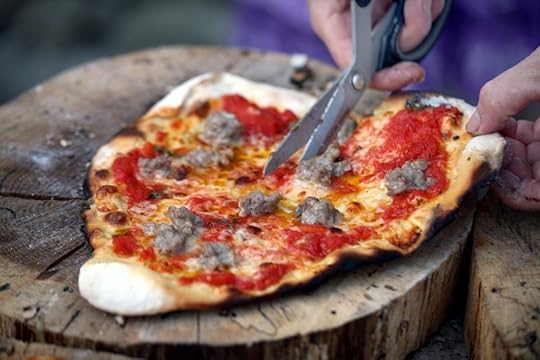
We use these cross sections from chestnut logs a lot. This is rustic pizza just out from its inferno. In contrast, is the more well-behaved version from our U.S. oven:

Writing all this gives me pangs for Tuscany. Winter from our mountain house looks like this:
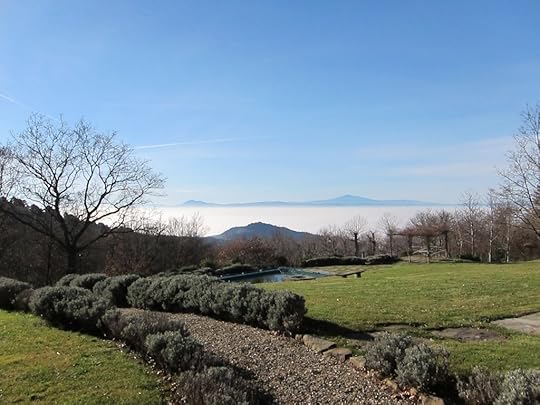
Those two extinct volcanoes on the horizon often seem to float above the fog. That's Cortona on the hill closer in. The lavender walk is in summer full of butterflies. If we were there now, friends coming over, supper would look likely be roast chicken and guinea hen, roasted vegetables and potatoes, green beans.
[image error]
But here we are in mild North Carolina, spending the weekend on garden chores, planting a few bare root roses, admiring yellow crocuses, converting a sad perennial bed to lawn, doubtless pulling a muscle while hoisting big pots. We've already discussed Sunday supper because we have a bunch of quail to slow roast with juniper berries, vin santo, and pancetta. Here's what it looks like.
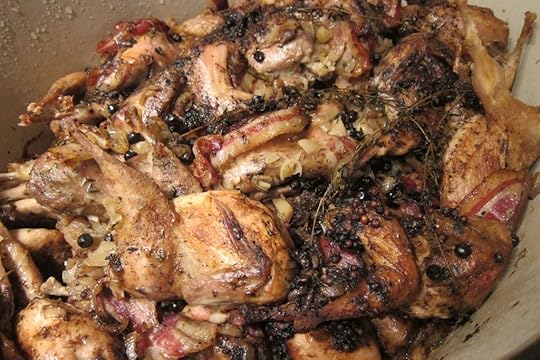
Incredibly easy, this quail covey tastes intensely savory. We serve it on a bed of cheese grits, the first cousin to polenta. Most things I'm describing will be in the cookbook. We have one early copy. Ed said, "I can't wait till its all stained with tomatoes and fingerprints, and crumbs drop out of the middle."
Buona Domenica. Happy Sunday.
January 23, 2012
Trees in Winter
This weekend we found a big fluffy cedar down in the driveway. It was only about twelve years old so shouldn't have fallen. No wind. No apparent disease. Just gave up the ghost. (What DOES that really mean??) Meanwhile, we're taking down lots of truly dead trees along our lane, ripping out ivy, and securing the fenceposts. Nothing makes a property look so derelict as broken fences! Winter is the best time to get these chores done. I was just thinking that when I saw Jeff Minnich's blog on tree work. He's a landscape designer in the D.C area who often comments on this blog . Take a look at his charming and informative blog: http://minnichgardendesign.com/blog/?p=351
January 19, 2012
Where To Go When
Now that trip-planning season and winter dreaming are intersecting, I want to recommend two big, coffee-table books. You won't be packing them in your suitcase, but perhaps will copy lots of info from them. As you see, I wrote a foreword for the Italian one. It's just a brief note. The real work was not mine!
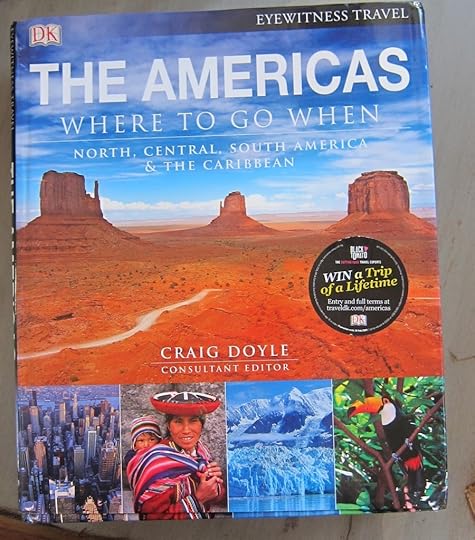
I hate it when stickers that won't come off are on my books! Mars the careful cover. Here's Italy. No sticker.
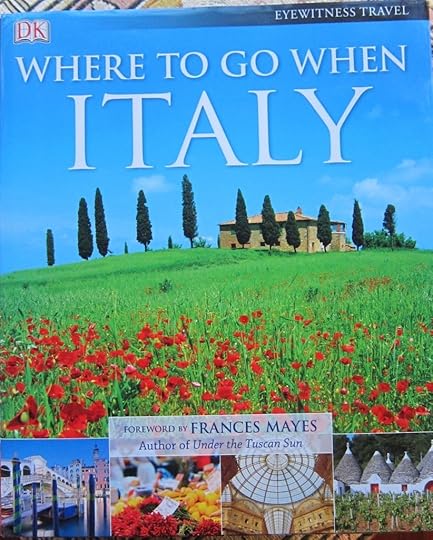
Where To Go When: Italy and Where To Go When: The Americas are both published by DK. They're organized by month, with suggestions for that time of year. The information is concise and useful, there are great photographs, and the editors have found many surprising or unknown places to lure us. This is a spread on Puglia.
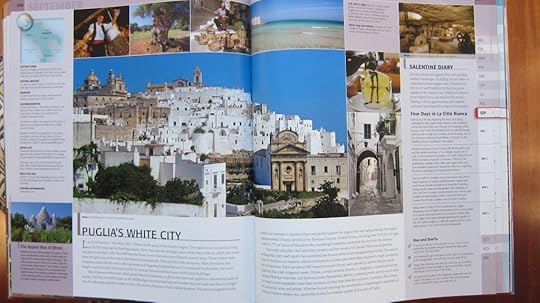
And Panama, a February suggestion, looks good to me.

The Americas book really lures me. There are so many places I have not seen south of the border. A trip to Central America and Peru remains one of my top travel memories. I've never been to Brazil or Argentina, or so many other places.
These books are magnetic!



